Roman science of war
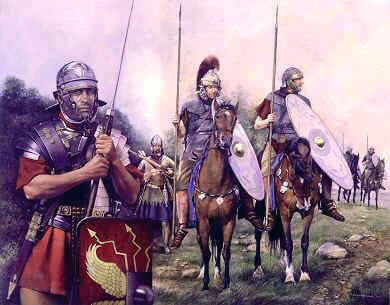 In the fourth century BC: Rome was almost completely ransacked by the Gauls. This seriously undermined his authority in central Italy. But this event led to an almost complete reorganization of the army. It is believed that the author of the reforms was the hero Flavius Camillus, but many historians agree that the reforms were adopted centrally throughout the fourth century BC.
In the fourth century BC: Rome was almost completely ransacked by the Gauls. This seriously undermined his authority in central Italy. But this event led to an almost complete reorganization of the army. It is believed that the author of the reforms was the hero Flavius Camillus, but many historians agree that the reforms were adopted centrally throughout the fourth century BC.Initial legions
Rejecting the phalanx, the Romans introduced a new order of battle. Now the soldiers were built and three lines. Gastatas who were second-class spearmen in the previous formation, phalanxes, stood in front. There were recruited young people dressed in armor and carrying a rectangular shield, scutum, which remained in service with the Roman legionnaires throughout stories. The Gastatas were armed with two 1,2-meter darts (pilum) and a traditional short sword, gladiator / gladius. In each manipula gastatov entered lightly warriors. In the phalanx system, they were attributed to the fourth and fifth grade.
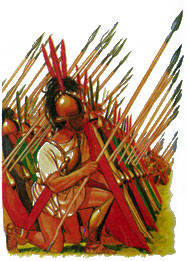 As long as the gastatas and principles fought, the triarii stood on the right knee, tipped forward the spears and covered themselves with shields to the left so as to protect themselves from enemy projectiles. They entered into battle only if gastatas and principles were defeated.
As long as the gastatas and principles fought, the triarii stood on the right knee, tipped forward the spears and covered themselves with shields to the left so as to protect themselves from enemy projectiles. They entered into battle only if gastatas and principles were defeated.The soldiers, first attributed to the first class, were divided into two types: principles and triarii. Together they formed the heavy infantry, the gastatists were the first to engage in combat. If they began to crush, they could retreat between the ranks of heavy infantry principles and restructure for a counterattack. Behind the principles at some distance were the triarii, who, as the heavy infantry retreated, stepped forward and brought confusion into the ranks of their enemies by the sudden appearance, thereby giving the principles the opportunity to reorganize. Triarii were usually the last line of defense, which, if the outcome of the battle was unsuccessful, covered the retreating gastatas and principles.
The weaponry of the legionnaires has undergone significant changes. Bronze helmets did not provide good protection against the long swords of the barbarians, and the Romans replaced them with iron helmets with a polished surface on which the swords slipped off (although later bronze helmets were again introduced into circulation).
Also, the adoption of Scutum, a large rectangular shield, greatly affected the effectiveness of the legionnaires.
At the beginning of the III century BC. Roman legions have proven themselves in battles against the well-trained Macedonian phalanxes and war elephants. In the same century, the First Carthaginian War hardened the Roman legions in battle even more, and by the end of the century the legions stopped the attempts of the gals to go south from the valley of the river Po, proving to everyone that the Roman legions were no match for the barbarians who had ravaged their city.
At the beginning of the Second Punic War, historian Polubius writes that Rome possessed the largest and best army in the Mediterranean, 6 legions consisting of 32 000 infantry and 1 600 cavalry, together with 30 000 allied infantry and 2 000 cavalry. And this is just a regular army. If Rome announced the collection of Allied troops, then he could count on 340 000 infantry and 37 000 cavalry.
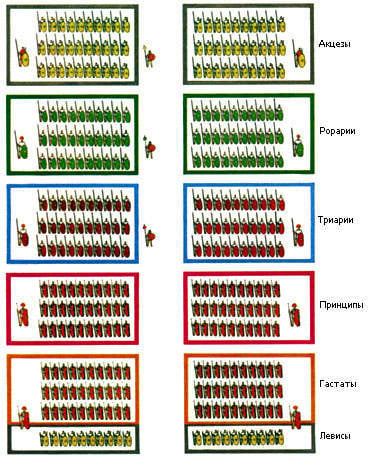
Scipio Reform
One of the people who made a great contribution and the prosperity and survival of Rome was Scipio Africanus. He was present at the defeat at Trebbia and Cannes, whence he learned the lesson that the Roman army needed to change tactics urgently. In the 25 years he became commander of the troops in Spain and began to train them more intensively. Undoubtedly, the Roman legionnaires were the best warriors of the time, but they needed to be prepared for the tactical tricks that Hannibal used on the battlefield. Scipio was on the right path and his victory over the troops of Hannibal under Zama, fully proved it.
The reform of Scipio radically changed the concept of the legions. Now the ode relied on tactical superiority, and not on the physical strength of the legionaries. Since that time, Roman soldiers went into battle under the leadership of smart officers who tried to outwit the enemy, and not just line up and march on the enemy.
In the second century BC the legion formation has changed a little. Soldiers used the gladius, also known as the "Spanish sword." The iron helmets were again replaced with bronze, but made of a thicker metal layer. Each manipula was commanded by a centurion 2, with the first centurion commanding the right side of the maniple, and the second - the left side.
As Rome conquered the east, more and more people were drawn into production, and lifelong army service became unacceptable. Rome could no longer rely on a continuous stream of legionnaires from villages in the provinces. Military service in Spain provoked discontent of the civilian population, and led to a series of local wars and uprisings. Human losses, injuries and a low influx of money into the treasury forced us to reconsider the time-tested method of recruitment into the army. In 152 BC it was decided to call citizens into the army by drawing lots for no more than 6 years of service.
The use of Allied troops has become more active. In 133 BC, Scipio took Numantia, two-thirds of his troops were Iberian troops. In the east, during the Battle of Pydna, which ended the Third Macedonian War, allied troops of Rome, using war elephants, defeated Perseus's left flank, thereby giving legionnaires the opportunity to approach the Macedonian phalanx and disrupt its ranks.
1 is a legion built for battle. Between units there are passages intended for rebuilds. If the gastatas and principles were defeated, they could retreat to the intervals left between the lines of triarii, rorrii and accents. Then the ranks closed and the whole army could begin a retreat under the protection of copies of the triarii.
2 - so the last row could close the gaps - pushing the rear centuria forward.
Reform Mary
It is Maria who is credited with the complete reform of the army, although she structured and introduced the final touches to the process that began much earlier. Rome in general, and the Roman army in particular, always opposed rapid reforms, considering a gradual change acceptable. Guy Grazia’s reform was that legionnaires were given equipment at the state’s expense and it was forbidden to recruit persons under the age of seventeen.
Mari, made the army accessible to all, even the poorest, the main thing is that they have a desire to serve. They were enrolled in the army for a lifetime of more than 6 years. For these people, military service in the army became a profession, an opportunity to make a career, and not just a return on debt to Rome. Thus, Marius became the first ruler in Roman history, who created a professional army. Mari also offered special benefits for veterans, and thus attracted them to the service. It was the new army that Maria saved Italy from the massive invasion of barbarian tribes, defeating the Germans first, and then defeating the Cimbres.
Mari also changed the pilum structure, replacing the metal shaft with a wooden one. Upon impact, it broke, and it was impossible to throw it back (as mentioned earlier, the tip of the pilum was bent upon impact, but it was very difficult to make a metal tip that deforms and at the same time causes significant damage).
Mari began to distribute land to the legionnaires after demobilization - giving guarantees to veterans, for a so-called pension, at the end of their service life.
The changes affected the battle order of the legion. The lines of battle order were abolished depending on the weapons. Now all the soldiers had the same equipment. Cohort tactics were actively used.
By the way, the cohorts appeared under Scipia Africanus, so it’s hard to say if it was Mary’s merit. Although no one denies that cohort tactics became dominant in the army, Maria, thanks to the fact that the boundary between the classes was erased, because all warriors were armed equally.
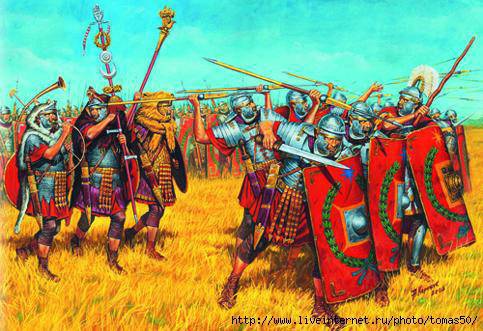
"Classic Legion"
Under the rule of Julius Caesar, the army became highly efficient, professional, highly trained and remarkably controlled.
On the march, the legion counted only on its own reserves. For staging the camp every night, each soldier carried instruments and two poles. In addition to this, he carried his weapon, armor, bowler, marching ration, clothing and personal items. Because of this, the legionaries got the nickname “Mula Maria”.
Disputes about how much a legionnaire actually carried on itself do not cease. In modern army fighter carries 30 kg on himself. According to calculations, including all equipment and X-NUMX-day’s ration of a legionnaire, it turns out that one soldier carried 16 kg. Legionnaires carried with them a dry ration, which at the rate of iron consumption by the soldier provided him on the 41 of the day. The weight of the ration was 3 kilogram. For comparison, before the soldiers carried with them grain rations weighing 3 kg.
During the reign of Emperor Constantine the Great, the infantry remained the main military force of the Roman army. With the introduction of regular cavalry, Constantine abolished the post of pretorian prefect and introduced instead two new posts: commander of the infantry and commander of the cavalry.
The increase in the value of cavalry is due to two main reasons. Many barbaric tribes avoided open invasion, but simply confined to raids. The infantry was simply simply not fast enough to intercept barbaric troops.
Another reason was that the superiority of the Roman legion over any rival was no longer as obvious as before. Barbarians have learned a lot over the past century. Thousands of Germans served as mercenaries and took over the experience of Roman commanders and used it on returning home. The Roman army had to adopt new tactical solutions and provide reliable support for heavy infantry with the help of cavalry. In the period from the third to the fourth century, the Roman army hastily increased the number of cavalry when a catastrophe occurred at the end of this period. In xnumx g. heavy Gothic cavalry completely destroyed the Eastern army led by Emperor Valens at the Battle of Adrianople. Now no one had any doubt that heavy cavalry could defeat heavy infantry ...

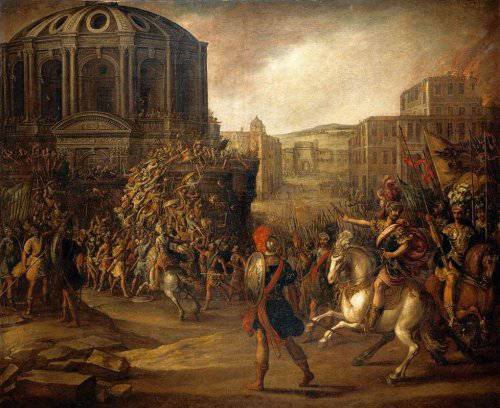
Information